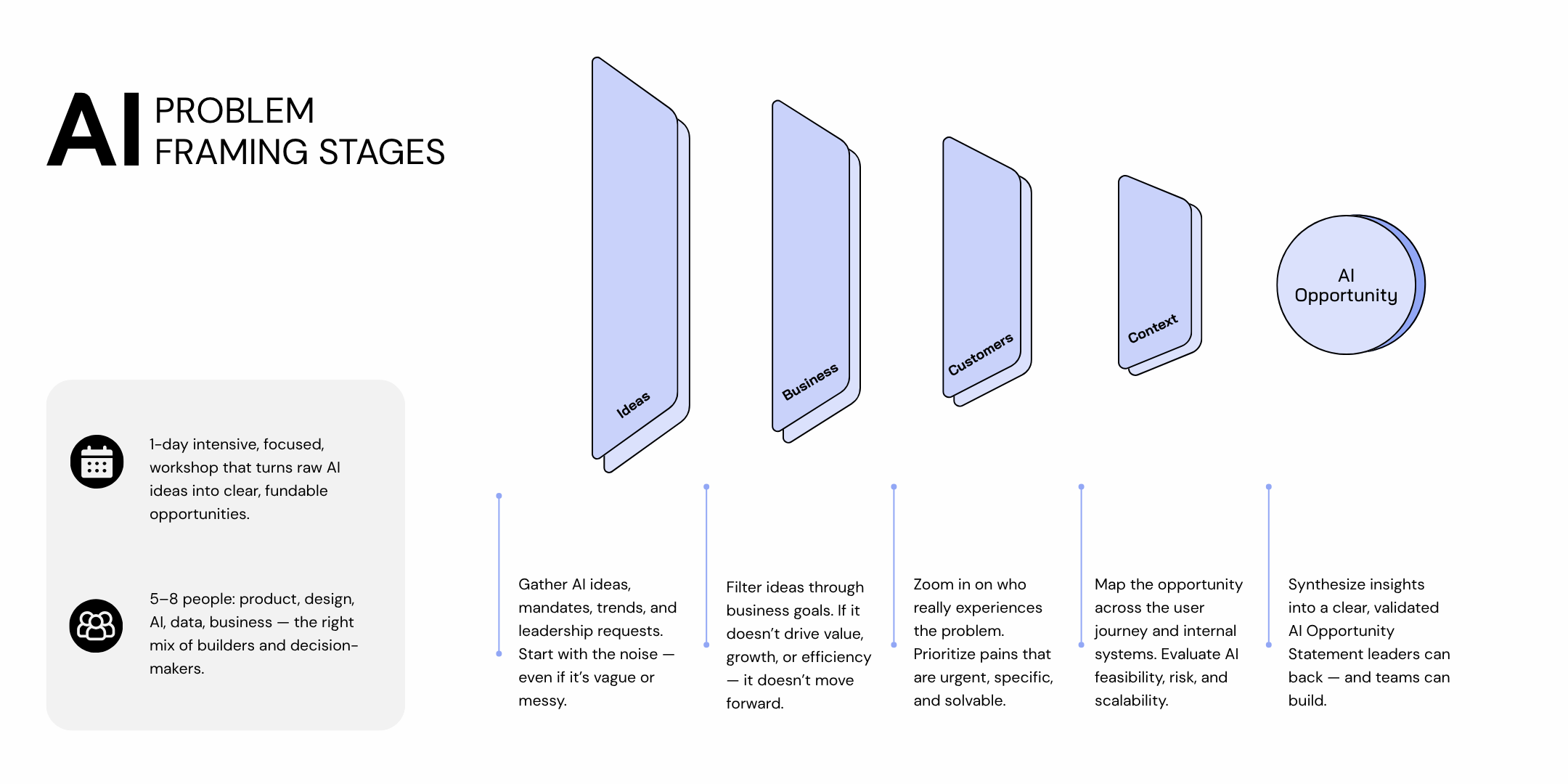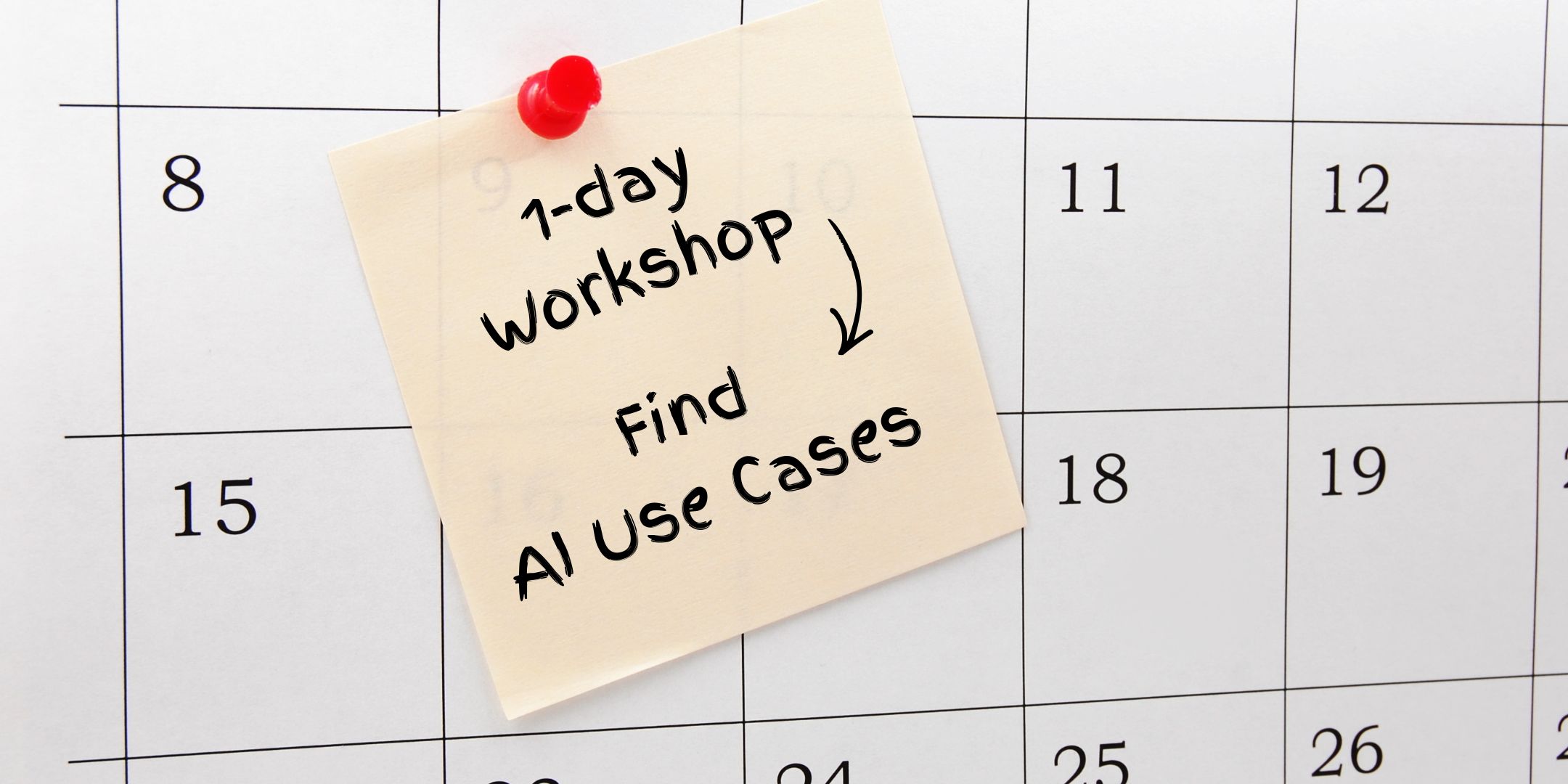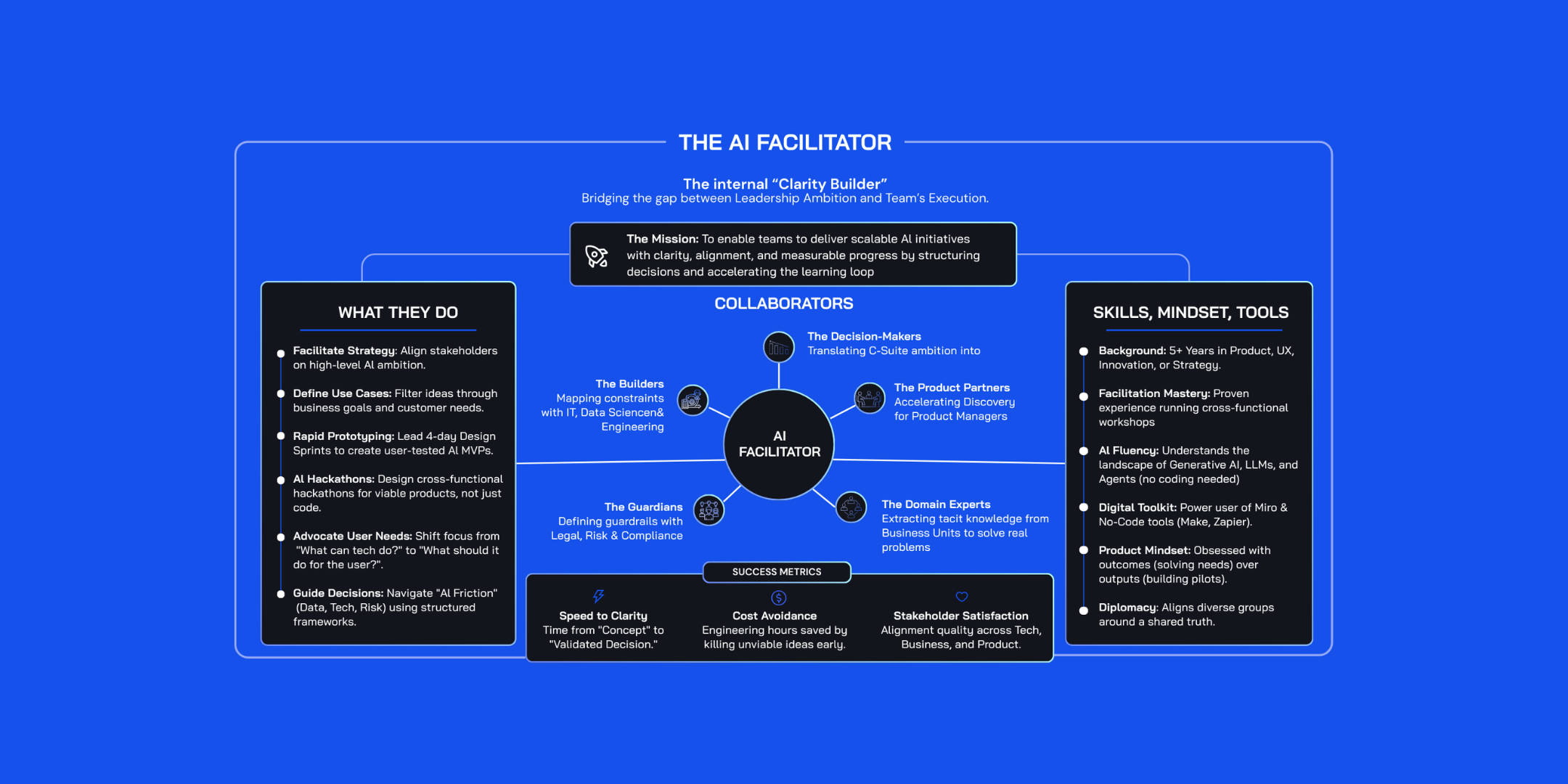AI Problem Framing

AI Stresses Everyone Out — And That’s OK
When AI first dropped, my first reaction was to ignore it. To tell myself that this “new thing” won’t change much. I did not want to engage with it. It just added more stress to my life.
But some people were truly excited. Others terrified and freaked out.
Today that’s still true. But with the pace of change accelerating, more and more people are feeling overwhelmed. Or worse—like they’re already falling behind.
Regardless of where you land on that spectrum—from super excited to totally freaked out—
AI stresses everyone out.
And I think that’s totally OK.
If we acknowledge that, then we can move forward.
Across industries, in nearly every company I speak to, the mandate is the same:
“Let’s do something with AI.”
It sounds visionary. But the AI stress is real.
And for most teams, that kind of open-ended mandate just leads to more questions than answers:
“What exactly are we supposed to do?”
“Where do we even start?”
That’s the question I want to help answer in this article.
Not from the perspective of a technologist, AI expert, or boardroom strategist but from the ground, after two decades of working with teams trying to build things that matter.
So why is it so hard to get started?
It’s Never Been Easier to Build. It’s Never Been Harder to Matter.
After all, with AI, it’s never been easier to build and launch something.
But that does not mean that it’s easier to build something that matters for customers. If anything, it’s harder. You’re no longer competing with a handful of teams. You’re competing with a hundred, using the same tools, building the same thing, at the same time.
AI makes competition tougher than ever. And speed alone won’t help, especially if you are running in the wrong direction.
It’s important to slow down just enough to get clear, and learning to think differently. To ask better questions. To avoid falling into the trap of “Let’s build something cool” just because we can and instead focus on:
What problem are we solving, and why does it matter?
Who is this for, and what makes us different?
Because despite all the change AI is bringing, one thing hasn’t changed. The number one reason companies—and their products—fail is simple: they don’t solve a big enough problem that actually matters to their customers.
So before we rush to build, we need to do something that seems counterintuitive in the age of AI: We need to stop. Think. Align.
And frame the problem—before we jump to solutions.
The teams that win in this new AI era won’t be the ones who move the fastest. They’ll be the ones who get focused first.
There’s already a pattern emerging.Everyone’s building. Everyone’s launching. But most of it looks the same: AI-powered chatbots, AI meeting notes, AI dashboards. A sea of sameness: slightly faster, and for the sake of argument, slightly better versions of the old stuff.
That’s not where you want to be. And that’s not where this technology wants to take us.
From Insight to Imagination: How Teams Can Stand Out
The real opportunity isn’t in copying what already exists and making it a little more efficient.It’s in building what wasn’t possible before and creating value in ways we couldn’t until now.
This requires two things:
- A deep understanding of customer problems
- The imagination to see what AI could make possible.
And here’s the trap many teams fall into.
Customer-first thinking sounds smart. Listening to users is crucial. But if that’s all you do, you end up solving the same safe problems everyone else is already tackling.
Meanwhile, AI is opening possibilities like never before. We're so obsessed with making AI do what humans used to do, we forgot to imagine what it could do that humans never could.
True differentiation comes from customer insight plus human creativity and intuition.
From connecting what’s painful, meaningful, or aspirational to what’s now suddenly possible.
If we want to do better, we need a way to combine insight with imagination, not by accident but by design.
That’s where AI Problem Framing comes in.
The Missing Middle: What AI Problem Framing Actually Is
The most superficial way to describe is: “it’s a workshop”.
I know. That word has been beaten to death. Most people hear “workshop” and picture post-it theater—some lightly structured team activity with no real outcome.
And yes, in form, it is a workshop.
But we chose the workshop format for a reason. Not because it’s trendy—but because building anything with AI isn’t one person’s job. You need people who understand the tech, yes—but you also need subject matter experts, customer voices, business context, and sometimes the people who’ll have to explain or scale the thing later. A workshop forces collaboration. It surfaces gaps in knowledge, capabilities, and priorities—and helps bridge them quickly. It brings together different functions, varying levels of AI literacy, and diverse ways of thinking to collide, align, and co-create.
But beneath the surface, it’s more than that.
It’s a practical, repeatable way for teams to get aligned before they start building.
A structured intervention that helps teams answer the questions most skip:
"What’s the real problem?", "Who really has it?", "And how does solving it move the business forward?"
In just one day, teams move from vague AI ideas and top-down pressure to clear, fundable opportunities grounded in reality, shaped by real user pain and future possibility.
The method is simple, but not simplistic.
It follows a fast, focused sequence:
- Map AI ideas to real business goals
- Identify and prioritize customer segments and their problems
- Contextualize the problem space so ideas are grounded in reality
- Use Opportunity Mapping to write crisp, high-confidence AI Opportunity Statements

And because we built this method inside real companies, on real projects, it’s built for speed.
Most teams reach clarity in a single working day. And they can repeat the process whenever they need it.
This is key. One flower does not make spring.
You want to scale this way of thinking at an organizational level.
For that, you need structure—a recipe teams can trust.
But having structures does not mean being rigid. Baked into that structure is something more important: freedom of thought, boldness, and room to imagine.
To make that possible, AI Problem Framing includes toolkits, facilitation assets, and a GPT-powered Copilot trained on the method—so teams can run framing sessions again and again, across different use cases, with consistency and confidence.
Now imagine this happening across your entire organization.
Teams no longer chasing random ideas, but using a shared lens to think deeply, vet opportunities, and move fast with intention and purpose.
Not just building quickly.
Building what matters.
When to do AI Problem Framing?
It’s important to understand that this is not board room strategy. The mandate is already there. AI Problem Framing sits in that missing middle, the moment teams are told “Make something happen”, but haven’t yet decided what or simply don’t know where to start.
Problem Framing fills that gap.
It creates the focus that speed requires.
But more than that, it helps teams build a clear, compelling narrative around the opportunities they want to pursue—and use that narrative to earn buy-in from leadership.
That builds trust on both sides.
Leaders gain confidence that teams are solving real problems, aligned to business goals.
Teams gain the freedom to explore and design solutions—without being told what to build.
Because too often, that’s exactly what happens:
An executive says, “Let’s build an AI chatbot”.
Just a request—delivered top-down—without rationale, without conversation, and without space to ask,
“Is this even the right thing to do?”
Which, for any team trying to work with purpose, is deeply frustrating, and over time it kills innovation and eventually motivation too. Not to mention the opportunity costs: the time, energy, and budget sunk into an ever-growing graveyard of failed initiatives.
That’s what Problem Framing helps prevent. And in doing so, it quietly solves the deeper organizational issues and cuts preventable losses.
Beyond Luck: Designing with Intent
By now, you probably see the benefits of Problem Framing.
And yet, you also know it’s not a common practice in your organization—or if it is, it happens inconsistently, in pockets, with a few strong-willed champions.
So why is that?
Most teams don’t skip framing because they don’t care.
They skip it because they’re busy. Because someone (let’s call them HIPPO) is already expecting a solution. Because there’s pressure to show “progress.”
And when AI tools make it so easy to build, it feels almost irresponsible not to start right away—especially when you see everyone else doing it.
So they build.
And once the ball is rolling, it feels wrong to stop and ask,
“Wait… what are we actually solving?”
So teams move forward, hoping the answer will emerge along the way.
Sometimes they get lucky. But in most cases, they end up with shiny pilots, that get applause but no traction as they don’t move the business forward.
Problem Framing changes that and it does it without disrupting how teams work, without requiring a reorg or massive process overhaul.
It’s not about adding a new process and frictions but more about creating a moment of focus, a space for teams to reflect, challenge assumptions and make informed decisions about what’s truly worth pursuing.
I won’t say that it guarantees success. No method can.
Ideas still need to be tested. Assumptions still need to be validated.
But now the team knows what they’re testing and why they’re doing it.
They have a narrative they can communicate.
The framed opportunities don’t sit on whiteboards or slide decks. They feed directly into action and becoming inputs for AI Design Sprints (or any problem-solving and validation method), where teams can prototype, validate, and move forward with confidence.
Framing doesn’t slow you down. It just makes sure you’re not moving fast in the wrong direction which in this AI era is the biggest risk. Not that you fall behind. But that you waste time, money, and talent building the wrong thing—beautifully.
Want to get a head start with AI Problem Framing?
Get our AI Problem Framing Facilitation Stack
.png)



.jpg)





